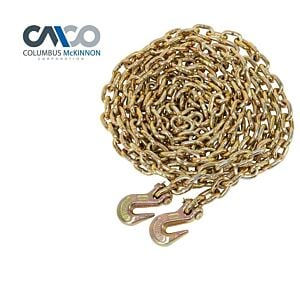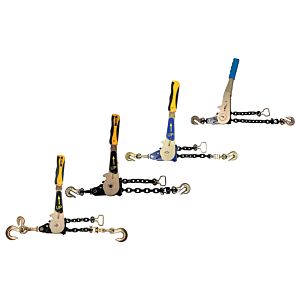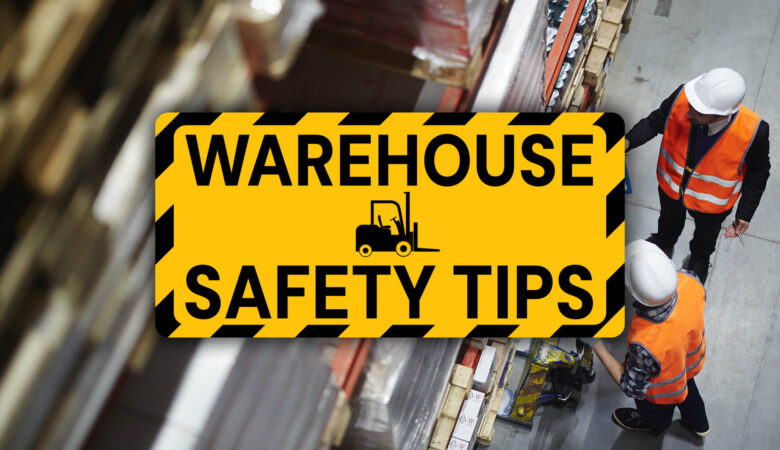For haulers who use heavy-duty chains to tie down their loads, choosing the right size, grade, and strength is crucial for the protection of your cargo and consistent legal compliance. Without the right chains, you may be at risk for cargo shifting and damage, as well as hefty fines.

In this blog, learn the basics of cargo chain grading and how to select the best chains for your hauling operations.
Top Cargo Chain Mistakes to Avoid
1. Using a hoist load chain for lifting
Using a hoist load chain for lifting is dangerous, as they are not built with the same flexibility and strength as rigging chains. This means alloy house load chains are likely to deform or break while being used for lifting, which can cause property damage or injury to the operator.
2. Improper storage and inspection
Storing your cargo chains incorrectly can cause damages that limit their strength and longevity. Be sure to keep your chains in a cool, dry area and away from harsh chemicals when not in use. Additionally, you should always inspect your chains before completing heavy-duty tie-downs to ensure effectiveness and avoid injuries.
How do you calculate a chain grade?
With several different ratings, you may be wondering: How do you calculate chain grades? A chain grade’s number or rating refers to the maximum stress it can handle per millimeter squared. If you were to make it a mathematical equation, it would look similar to the following:
Chain Grade = Maximum Tensile Force (Newtons)/Link Cross-Sectional Area (millimeters)2
Breaking down tow chain ratings using this equation, you could discover that a G70 chain can endure 700 Newtons per millimeter squared before bending, disfiguring, or breaking. Remember, the higher the grade, the higher the tensile strength is compared to the size of the chain links.
This equation works for nearly every chain on the chain chart until you get to chains that are designed with different materials. Carbon steel chains, like Grade 30, 43, and 70, cannot handle the stress/Newtons required for tasks such as overhead lifting. Meanwhile, alloy steel chains – like Grade 80 and higher – can handle that kind of tensile force and thus are recommended for any heavy-duty lifting.
Chain Grade Chart

Chain Grade Overview
Grade 30
With the smallest amount of strength on the list, grade 30 chains are perfect for light construction and agricultural uses, or any economical application that requires low stress. Made of malleable, rust-resistant carbon steel, they typically have a working load limit between 1,300 to 6,900 pounds.
Grade 43
One step above the grade 30 chain is grade 43. This chain grade is ideal for slightly more demanding jobs, such as logging and auto towing, but it can also be used as a general-purpose utility chain for trucking. They usually have a working load limit of 2,600 to 13,000 pounds.
Grade 70
The most common cargo chain is the grade 70. Often coated in a yellow chrome finish, the G70 chain has a load rating roughly 20% higher than grade 43, making it the strongest carbon steel chain available. Their working load limit of 3,150 to 15,800 pounds makes them suitable for more heavy-duty towing jobs.
Also Read: Important Tips on Grade 70 Chain Usage
Grade 80
Unlike the previous chains, the grade 80 chain is rated as a sling for overhead lifting and heavy-duty towing. Often called an alloy chain, its unique alloy material and black coat finish make this chain’s strength incredibly high, offering a working load limit of 3,500 to 18,100 pounds.
Grade 100
About 25% stronger than grade 80, grade 100 is the strongest chain on most suppliers’ markets. G100 is made of a strong alloy steel and can be used in a variety of jobs, including overhead lifting. Based on the size of the links, G100 chains have working load limits between 4,300 and 22,600 pounds.
Grade 120
Chain grade 120 is the strongest chain available. 20% stronger than grade 100, G120 chains are the most distinguishable because of their unique design, bright, blue-coat finish, and rectangular links. They have a working load limit of 5,200 to 27,500 pounds and are built to fit the most rigorous job requirements.
Determining Chain Working Load Limits

Other safety measures that were put into place when identifying which chains are appropriate and safe for overhead lifting was determining the working load limit of each chain grade. The working load limit of a chain differs depending on the size of the links, as seen in the chain number chart above. It’s integral that you know the total weight of the cargo you plan to haul or lift before you purchase any chain rating.
The chain’s working load limit does not have to match the weight of the load, it only needs to be able to handle the stress and tension when applied – this is based on the surface that is being moved plus the weight of the load. Similar to when people ask how to identify chain grades, determining the working load limit of chain grades can be determined with a formula!
WLL = Minimum Breaking Load (MBL)/Safety Factor (SF)
The working load limit of a chain is significantly less than the weight that would cause a chain to fail (the tensile strength of a chain). A safety factor is a ratio between allowable stress and actual stress that the chain can withstand – the ratio between the chain strength and the expected maximum stress! When it comes to lifting and securement, factors like gravity and additional force – like sharp angles – should also be considered. It’s better to be safer than sorry, so spending a little more money on extra chains or a higher chain grade to ensure your chain limit isn’t less than your cargo’s weight can make all the difference! No matter what, always adhere to the WLL of a chain to ensure it doesn’t break or wear down fast.
Factors to Consider When Choosing Chain Grades
1. Weight & Type of Cargo
The type of chain you use depends on the weight and type of cargo you’re hauling. The chain’s working load limit, the maximum load weight it can handle under proper operating conditions, should always be higher than the weight of the cargo itself to avoid damage and injury.
2. Government Regulations
The Department of Transportation (DOT) and Commercial Vehicle Safety Alliance (CVSA) have guidelines in place for truckers and haulers to prevent accidents on the road. Anyone hauling heavy loads must check state and federal regulations for cargo securement, as they can vary depending on where you are and what you’re carrying.
3. Environmental Conditions
Outdoor hauling means that your chains and other equipment are often subjected to severe weather conditions that can cause wear and tear over time. The best way to protect your chains from rust and corrosion is to check for resistant materials, such as zinc-plating or chromate finishes.
Shop Durable & Reliable Chains from Mytee
Choosing the right chains is essential for safe, efficient, and compliant hauling operations. With a solid understanding of cargo chain grades and outside factors that may affect their functionality, you can prevent unwanted injuries and damage to your cargo.
For high-quality cargo chains built to keep you hauling safely through every obstacle, check out our full selection at myteeproducts.com today.

















































